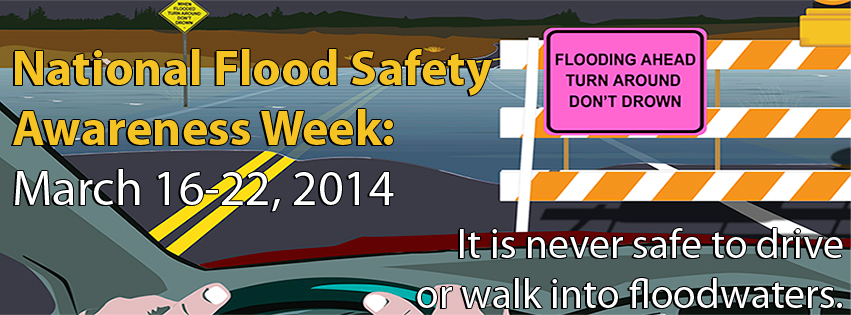
Day Three - Flood Hazards
A flood is defined as any high flow, overflow or inundation of water that causes or threatens damage. Flooding can occur with prolonged rainfall over several days, intense rainfall over a short period of time, or when water from an existing source moves too quickly (i.e. snowmelt, dam break, etc.). Brief descriptions of the various types of flooding you may experience are found below. More information about these flood hazards can be found on the NWS Flood Safety Website at WWW.FLOODSAFETY.NOAA.GOV.
Flash flooding is a rapid and extreme flow of high water into a normal dry area, or a rapid water level rise in a stream or creek above a predetermined flood level, beginning within six hours of the causative event (i.e. intense rainfall, ice jam, dam failure). River flooding occurs when rivers rise and overflow their banks, inundating areas that are normally dry.
Tropical Systems and Coastal Flooding: At any time of year, a storm from over the ocean can bring heavy precipitation to the U.S. coasts. Whether such a storm is tropical or not, prolonged periods of heavy precipitation can cause freshwater flooding in coastal areas, as well as further inland as the storm moves on shore. In addition to the freshwater flooding threat, tropical storms and nor'easters can bring the threat of storm surge related coastal flooding.
Burn Scars/Debris Flows: Wildfires burn away the vegetation of an area, leaving behind bare ground that tends to repel water. When rain falls, it runs off a burn scar towrad a low-lying area, sometimes carrying branches, soil and other debris along with it. Without vegetation to hold the soil in place, flooding can produce mud and debris flows.
Snowmelt:Flooding due to snowmelt most often occurs in the spring when warming temperatures quickly melt the snow. The water runs off the still partially frozen or already saturated ground into nearby streams and rivers, causing them to rapidly rise and sometimes overflow their banks.
Ice and Debris Jams: A backup of water into surrounding areas can occur when a river or stream is blocked by a build-up of ice or other debris.
Dry Wash:When heavy rain falls over dry land, the water rushes toward low-lying areas, which may include dried up canyon or stream beds. This can quickly turn a dry channel into a raging river.
Dam Break and Levee Failure:A break or failure can occur with little or no warning. Most often they are caused by water overtopping the structure, excessive seepage through the surrounding ground, or a structural failure.
Understanding the different flood hazards and knowing the actions to take before, during and afternoon can help you protect your life, the lives of your loved ones, and your property. Prepare now by visiting WWW.FLOODSAFETY.NOAA.GOV
JOIN US TOMORROW FOR INFORMATION ON FLOOD RELATED SERVICES PROVIDED BY THE NATIONAL WEATHER SERVICE.
